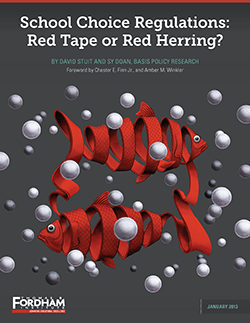 |
Will private schools avoid voucher and tax credit scholarship programs if they’re overregulated? Many friends of private school choice insist that they will, particularly if these schools are required to participate in testing and accountability mandates. But the findings from a new study released today by the Thomas B. Fordham Institute indicate these friends might need an intervention.
In their report, School Choice Regulations: Red Tape or Red Herring?, researchers David Stuit and Sy Doan find little evidence that policymakers should avoid testing requirements for fear that private schools will avoid voucher and tax credit scholarship programs altogether. In fact, in a survey of school leaders who qualify for four existing private school choice programs, just 25 percent said that state assessment rules figured “very importantly” into their decision on whether to participate.
Of greater concern to these school leaders were laws that forced them to revise their admissions criteria or restricted their religious practices, indicating that private schools were allergic to policies that made them less “private.” But, chiefly, just 3 percent of private schools that opted not to participate in these programs cited government regulations as the most important reason. Indeed, more schools opted out because there weren’t enough eligible students in their vicinity to begin with.
This doesn’t imply that policy makers should burden voucher programs with unnecessary regulations. Of the non-participating schools that Stuit and Doan surveyed, 27 percent still identified government regulations as one of the top three reasons they opted out. And in a separate analysis of thirteen voucher and tax credit scholarship programs nationwide, the researchers found that the greater the regulatory burden on private schools, the less likely that schools would participate.
But testing is not, for most, a burden. While one in four school leaders said that a requirement for state testing figured highly in decisions to participate, even fewer (17 percent) had aversions to publicly reporting their test results.
It’s also notable that Catholic schools, which account for 40 percent of private school enrollments nationally, were least likely to make their decisions based on the regulations they’d face. Of course, vouchers have helped to replenish the declining enrollments Catholic schools experience annually, but voucher and tax credit scholarship programs also align well with the mission of Catholic schools to serve the poorest students in their communities.
That mission is shared by most schools surveyed in this report. Most (87 percent) of the surveyed school principals said they participated in their states’ voucher programs because it helped them expand their mission in their respective communities, and 72 percent said these programs helped them aid the neediest children in their midst.
So what can policy makers do to assure that disadvantaged and underserved children can have access to private options they otherwise wouldn’t have while reasonably (and necessarily) regulating these programs in the public interest?
For starters, and perhaps most fundamentally, states should minimize the amount of paperwork required of participating schools. Programs like the Florida Tax Credit Scholarship have centralized the task of verifying the eligibility of families seeking aid, but most programs burden the schools with these requirements, a problem for smaller schools that lack that sort of central-office capacity. Not surprisingly, nearly 60 percent of non-participating schools cited the amount of paperwork required as a “very important” or “extremely important” factor in their decisions.
But the study also suggests that the more states try to infringe upon a private school’s admissions standards or its religious freedom (or their freedom to be religious), the more likely a school will shun these programs outright, which hardly helps the students whom the vouchers were intended to serve. Stuit and Doan recommend financial incentives, not regulatory “penalties,” for schools that follow state academic standards or open-enrollment policies—a good idea that has yet to be implemented in any state.
Another good policy is to make sure that in any case where there is public support for private education, parents and taxpayers can compare the performance of voucher kids with their peers in public schools. And the best way to do that is by using the available state assessments. Arguably, the public-policy groups and private school associations that have long resisted such a policy may have kept the value of vouchers and tax credit scholarship artificially low via political means. They have done no favor to private school leaders, most of whom have few concerns about state testing but do worry that voucher amounts haven’t kept pace with their tuitions.
Greater accountability for more money seems a good tradeoff and, with this latest addition to the literature of school choice, hardly seems counterintuitive.
Click here to download School Choice Regulations: Red Tape or Red Herring?
